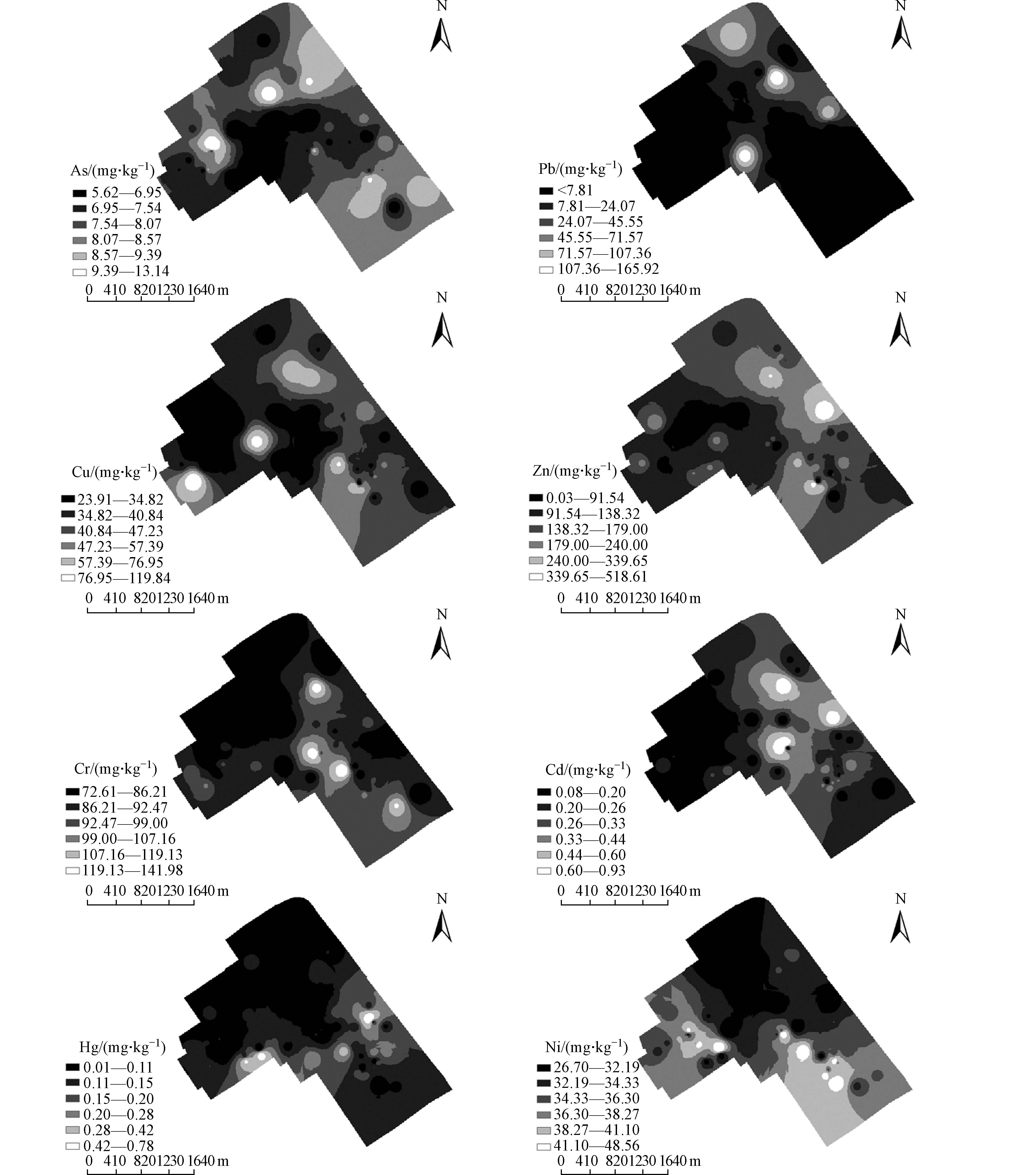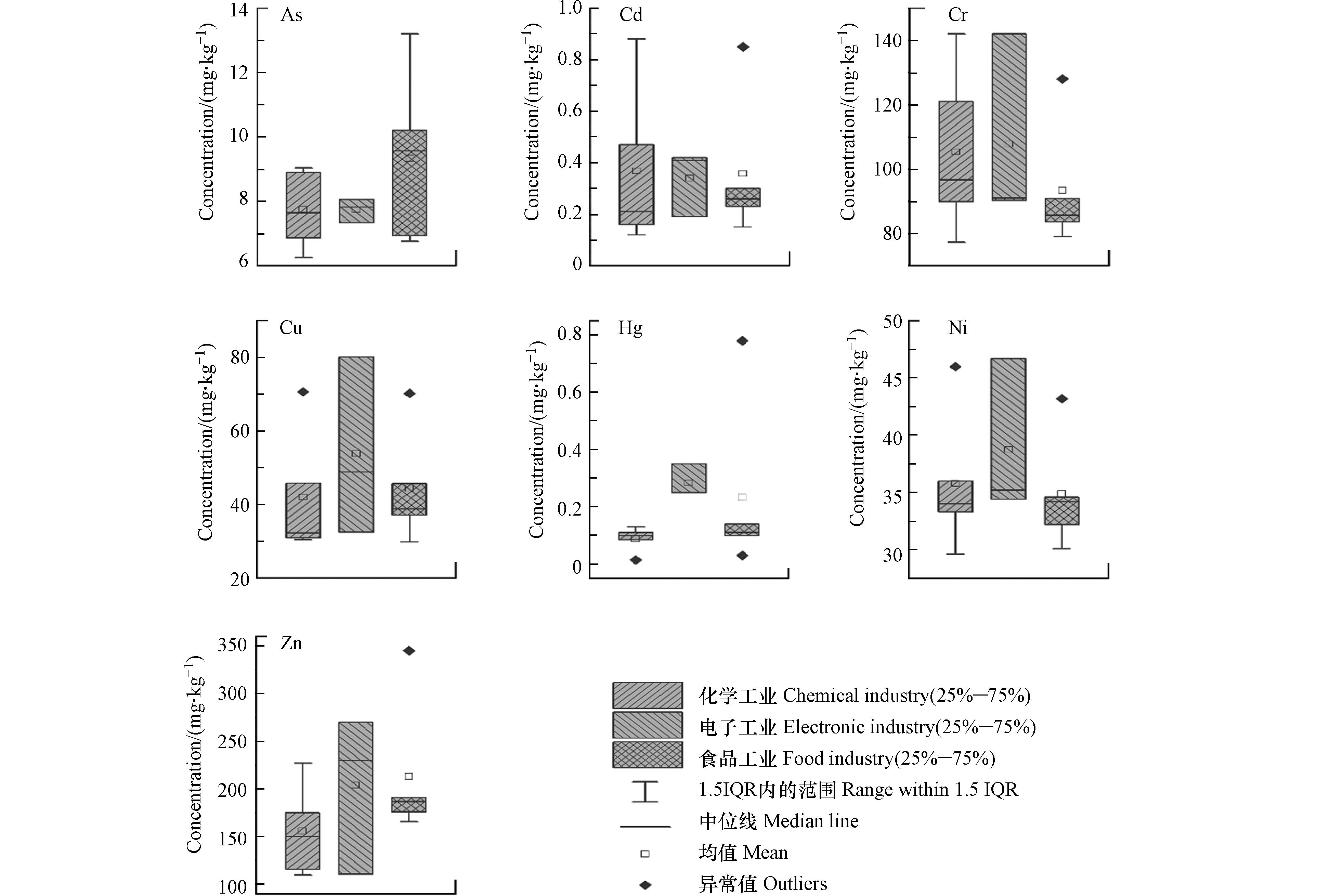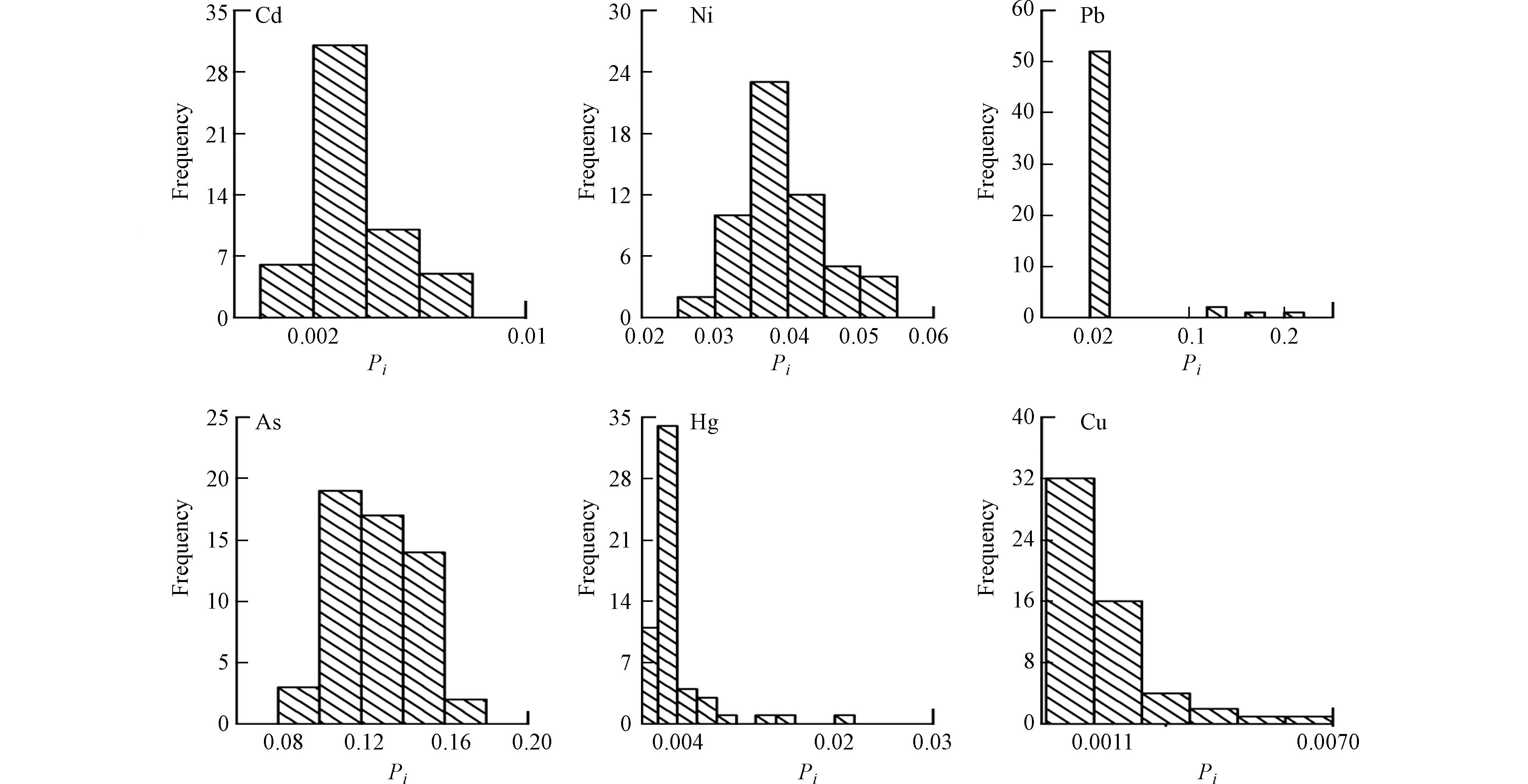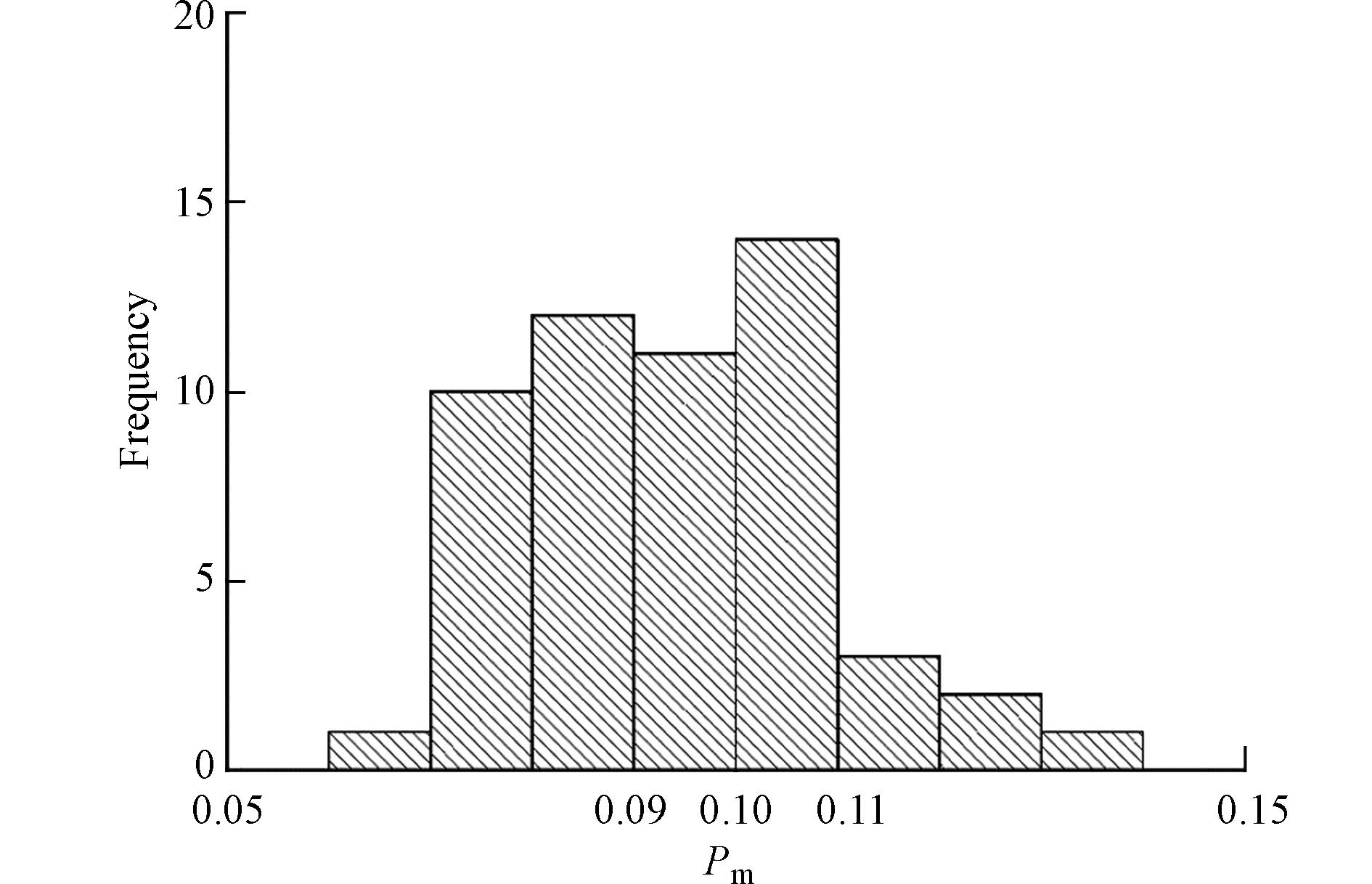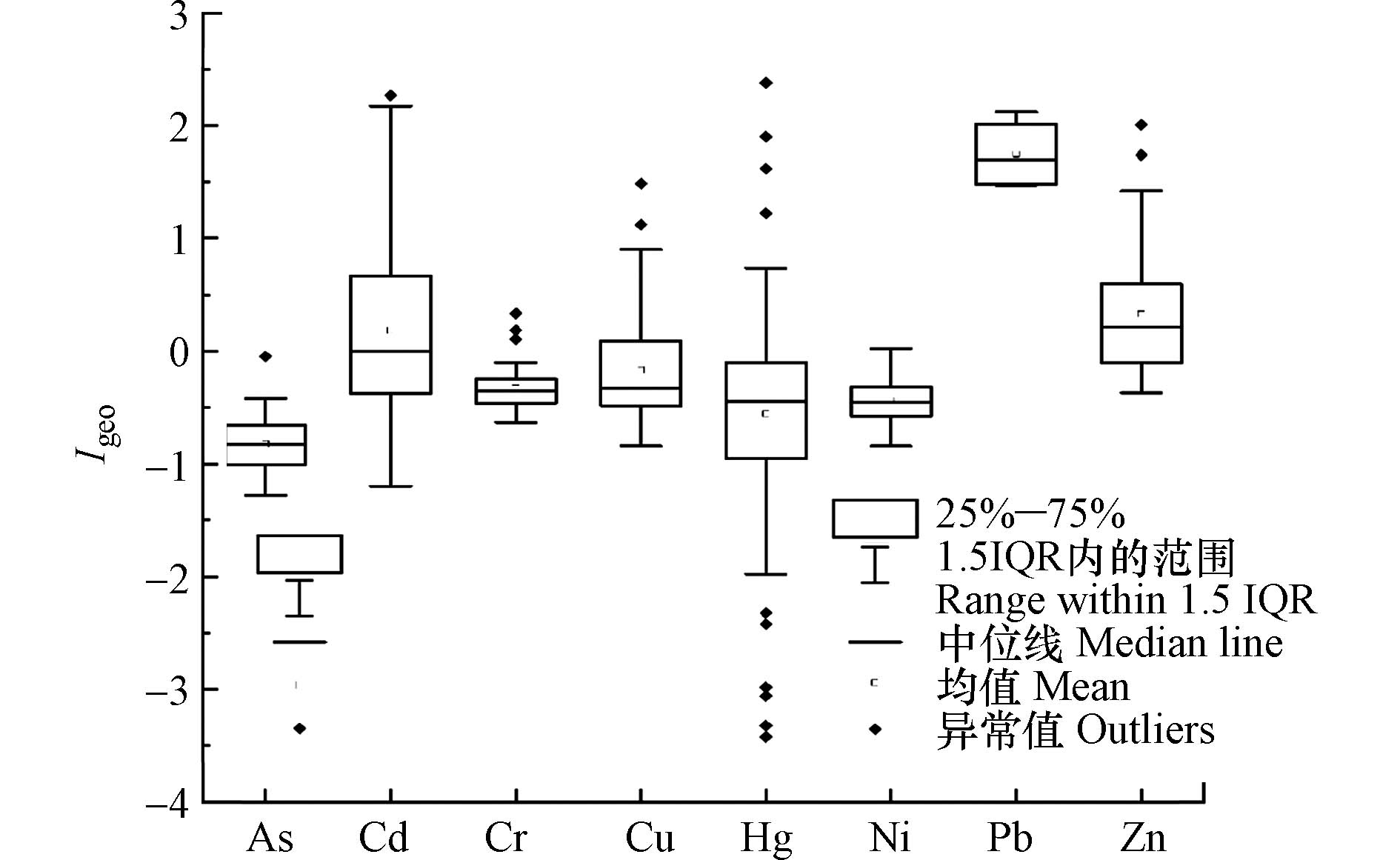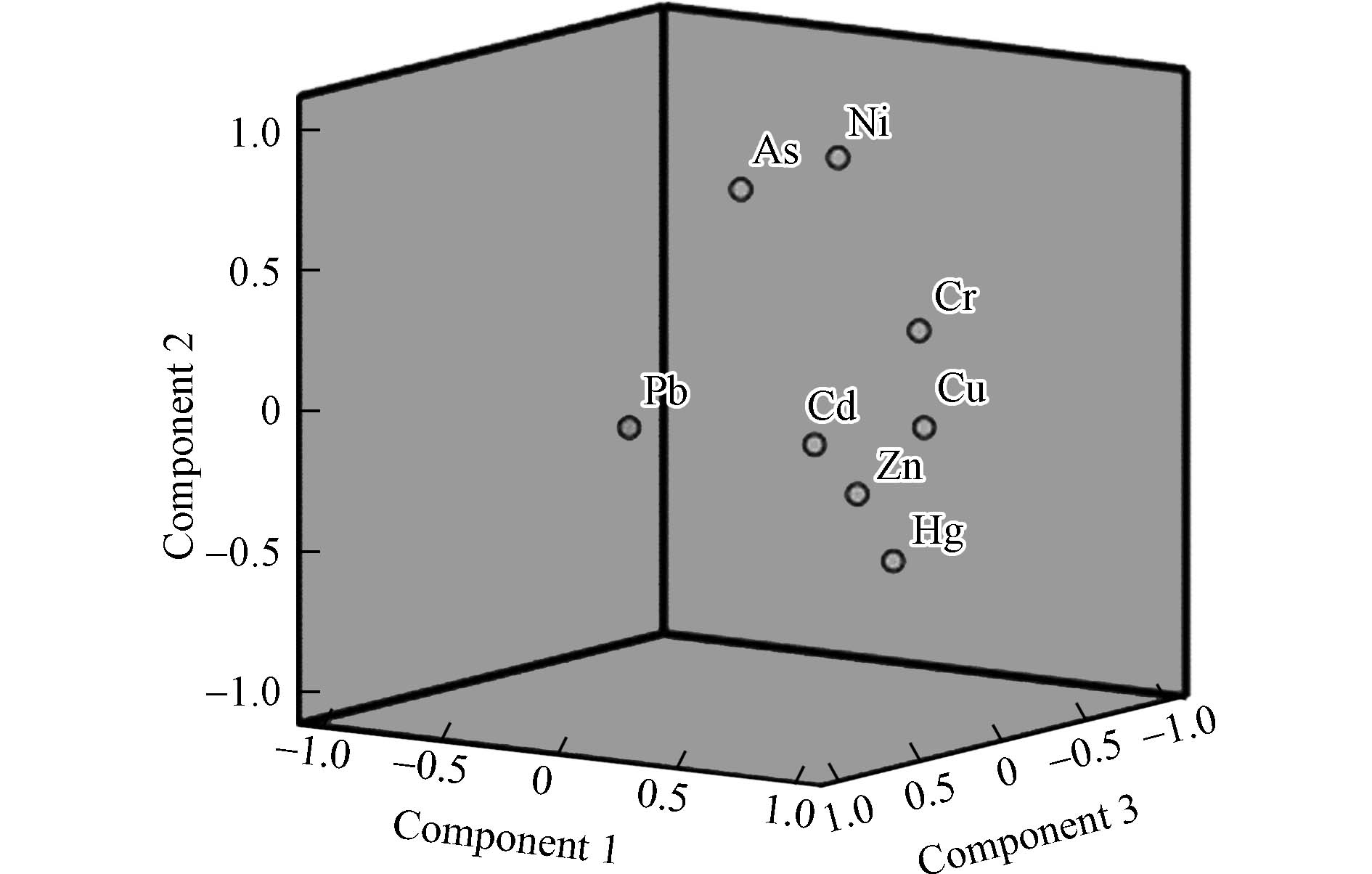-
在城市经济快速发展进程中,工业生产逐渐成为城市土壤重金属污染的主要驱动力,生产排放的污染物中重金属在土壤中累积,使土壤重金属含量逐渐高于其自然背景值,呈现土壤重金属污染现象,造成生态破坏和环境质量恶化[1]. 同时,加速的城市化进程带来城市人口的急剧增长,土壤中重金属的累积对居民的身体健康和城市发展也构成了潜在威胁[2-4],因此,对城市工业区土壤中重金属的污染状况及其来源进行分析具有重要意义.
近年来,城市土壤的重金属污染现象日益严重,城市土壤环境质量评价、生态风险以及污染源解析等引起国内外学者的广泛关注[5-8]. 长江三角洲是我国经济最发达的区域之一,高强度经济开发和人类活动造成的土壤环境质量下降问题亟需解决[9]. 上海市作为长江三角洲人口密度最大的城市,其土壤重金属的污染风险对居民生活和生态环境的影响应该引起高度重视. 目前对上海市土壤的研究主要集中在农田土壤[10-11]和公园土壤[3]的环境质量评价,对工业区土壤的关注度还很低. 同时,土壤作为时空连续的变异体,具有较高的空间异质性,而城市工业区土壤重金属含量受到人为高强度利用的影响,其空间变异更为复杂. 因此,应提高对城市工业区土壤重金属污染风险的关注度.
本研究对城市工业区(以上海市闵行区为例)土壤进行采样调查,对重金属砷(As)、铅(Pb)、铜(Cu)、锌(Zn)、铬(Cr)、镉(Cd)、汞(Hg)和镍(Ni)的含量进行测定,应用反距离加权法(inverse distance weighting)分析土壤重金属元素的空间分布特征,综合利用单因子污染指数、内梅罗综合污染指数和地累积指数对上海城市工业区土壤重金属污染现状进行评价,并利用相关性分析和主成分-多元线性回归(PCA-MLR)受体模型进行来源解析,有助于对上海典型城市工业区土壤质量进行全面了解,以期为城市工业区土壤重金属污染防控与修复提供基础的数据支撑.
-
研究区位于上海市中部的闵行区,中心位置地理坐标为北纬31°5′,东经121°25′,总面积372.56 km2,截至2019年底,闵行区常住人口为254.93万人,人口高度密集. 闵行区属于北亚热带海洋性季风气候,年均温约17.4 ℃,年降水量约956—1263 mm. 地势平坦,西部处于湖积平原,中东部和吴泾地区处于滨海平原上. 黄浦江贯穿的闵行区,水利交通便利. 区内有莘庄工业区、4个区级工业区和13个镇级工业园区,工业企业3400多家. 20世纪90年代以来,工业园区在推动经济的同时可能带来土壤重金属污染的潜在风险[12]. 因此,城市工业区土壤的环境质量与居民生活和城市生态环境密切相关.
-
根据研究区不同类型工业进行布点(图1),在工业园区内花坛采集表层土壤(0—20 cm)样品共56个,每个样点采用5点取样法,均匀混合后取1 kg混合样放入自封袋. 在土壤采集过程中,利用手持GPS对实际采样点进行定位. 将采集的土壤样品带回实验室自然风干后,剔除样品中的植物根系、有机残渣和可见侵入体,以减少对土壤有机质等理化性质及其重金属元素含量测定的影响. 将风干的土壤样品分别研磨过2 mm和0.149 mm孔径筛后存放,以备土壤pH和重金属元素(As、Pb、Cu、Zn、Cr、Cd、Hg和Ni)分析.
-
土壤pH采用玻璃电极法测定,称取过2 mm孔径筛的土样10 g于烧杯中,加入25 mL去CO2水(1:2.5土水比溶液),轻轻摇动后用电磁搅拌器搅拌1 min,使水和土充分混合均匀,放置30 min,用pH计测定上部溶液的pH值[13].
土壤的Cd、Pb、Cu、Cr、Ni、Zn用电感耦合等离子体质谱(ICP-MS; American Thermo Scientific, X7)测定,测定前对样品进行前处理,称取0.1000 g精确到0.0002 g过0.149 mm孔径筛的土样于聚四氟乙烯烧杯中,用少量去离子水润湿,摇匀样品后加入5 mL HNO3、5 mL HF、1 mL HClO4后加盖,于电热板上150 ℃加热2 h,升温至180 ℃加热1 h,用少许水冲洗盖子后,再加入3 mL HNO3、3 mL HF、1 mL HClO4,于电热板上200 ℃加热值白烟冒尽,加入1% HNO3温热溶解,溶解盐类后,用1% HNO3定容至50 mL容量瓶,摇匀并静置4 h后,用ICP-MS测定[14]. As和Hg用原子荧光光度计测定(AFS; Beijing Jitian Instruments Co., Ltd. production, AFS-820),测定前取0.250 g土样放入25 mL比色管,用少许去离子水润湿后,加入(1+1)王水(HNO3:HCl=3:1)10 mL,摇匀后冷消化过夜. 次日沸水浴2 h后用去离子水定容至刻度,摇匀后静置,待溶液澄清后上机测定[14]. 标准物质GBW07363和GBW07429用于实验结果质量控制.
-
应用指数评价法对研究区土壤重金属累积特征进行评价,指数法是将实际测得的重金属元素浓度值代入公式得到相应得污染指数并与相应的评价标准作比较以确定污染等级的方法,本研究中使用的指数法包括单因子污染指数法、内梅罗综合污染指数法和地累积指数法. 土壤重金属来源解析采用主成分分析-多元线性回归(principal component analysis-multivariate linear regression, PCA-MLR)模型解析法进行分析. 土壤重金属累积的空间分布特征采用地统计方法.
-
单因子指数法是目前通用的一种重金属污染评价方法,一般以土壤元素的背景值或标准限值作为评价标准[15],方法表达式如式(1):
其中Pi为土壤中污染物i的单项污染指数,Ci为土壤中污染物i的实测数据,Si为污染物i的评价标准(表1). 根据污染指数的大小将土壤重金属污染程度划分为5类(表2).
-
内梅罗综合指数法能够全面反映土壤环境中各项重金属污染指标综合后总的土壤环境质量状况,并突出高浓度污染物对环境质量的影响[18],是土壤重金属污染评价应用较为广泛的方法之一,方法表达式如式(2):
式中,
$ {P}_{\mathrm{m}} $ 为重金属综合污染指数,$ {P}_{i} $ 为土壤重金属单因子污染指数,$ {{P}_{i}}_{\mathrm{m}\mathrm{a}\mathrm{x}} $ 为土壤重金属元素单因子污染指数最大值,$ {{P}_{i}}_{\mathrm{m}\mathrm{e}\mathrm{a}\mathrm{n}} $ 为土壤重金属元素单因子污染指数平均值. 内梅罗综合污染指数分为5个等级(表2). -
采用德国科学家Muller在1969年提出的地累积指数(index of geo-accumulation, Igeo)对重金属污染程度进行定量分析[19]. 地累积指数不仅考虑了自然地质过程造成的背景值对重金属污染的影响,也考虑了人为活动对重金属污染的影响. 该指数不仅反映了重金属分布的自然变化特征,还可以判别人为活动对环境的影响,是区分人为活动影响的重要参数. 方法表达式如式(3):
式中,
$ {I}_{\mathrm{g}\mathrm{e}\mathrm{o}} $ 为重金属地累积指数,$ {C}_{\mathrm{n}} $ 为重金属元素实测值,$ {B}_{\mathrm{n}} $ 为该元素背景值(表1),本研究中元素背景值采用上海土壤环境背景值[10,17,20],并将地累积指数分为7个级别[19,21-22](表3). -
PCA-MLR模型是一种重要的受体模型,能够定性识别进而定量解析大气、土壤中污染物的来源,本研究利用该模型分析闵行工业区土壤中主要污染源类型及贡献率[23]. PCA-MLR的基本原理是通过分析受体信息,提取多个因子并对应识别为不同的污染源类型,估算污染源对受体的贡献值[24]. 首先利用“降维”的方法,通过主成分分析提取因子特征根大于1的因子,根据主成分在土壤重金属各组分上的载荷,推断该主成分所反映的污染源,再通过最小二乘法,在识别源的基础上(式4),将自变量和因变量标准化后对等式进行回归分析后(式5),根据式6得到土壤重金属污染源i的平均贡献率[25].
式中,Y为土壤重金属元素浓度,n为主成分个数,Xi为主成分分析中因子得分变量,b为未被因子解释的剩余变量信息.
式中,Bi为多元线性回归系数.
式中,Ci为土壤重金属污染源i贡献率.
-
反距离加权法[26](Inverse distance weighting)是基于两个物体之间的距离,根据相似相近原理的基本属性,两者之间的距离越近,则他们之间的属性就会越相似;反之,两者之间属性的差异就会越大. 其计算公式如下:
其中,
$ {\hat{Z}}_{\left({S}_{0}\right)} $ 为预测点$ {S}_{0} $ 的预测值,$ {Z}_{\left({S}_{i}\right)} $ 为预测点$ {S}_{i} $ 的预测值,$ {\lambda }_{i} $ 为估计过程中测量点$ {S}_{i} $ 的权重,与$ {S}_{0} $ 和$ {S}_{i} $ 的距离呈反比,N为参与估计的测量点数.反距离加权法是空间插值最常用的方法之一[27],通过反距离加权法可以进行土壤重金属空间结果分析、模拟和估值,进而揭示土壤重金属累积的空间分布特征[28].
-
土壤基础理化性质和重金属含量、污染指数、相关性以及主成分分析等采用Excel 2016和SPSS 19.0软件完成;采用ArcGIS 10.2对土壤采样点、重金属空间分布进行分析和作图.
-
通过表4可以看出,该研究区土壤pH值的范围为7.18—8.49,呈碱性. 戴彬等[29]的研究表明,土壤重金属在碱性条件下不易发生迁移. 但是随着时间的推移,土壤重金属累积显著,说明在研究区工业化和城市化迅速发展的背景下,土壤重金属累积主要受到外源输入的影响. 土壤中As、Cd、Cr、Cu、Hg、Ni、Pb和Zn的平均值分别为7.80、0.27、90.48、41.11、0.14、35.57、9.49、150.67 mg·kg−1,参照《土壤环境质量 建设用地土壤污染风险管控标准》(GB36600—2018)[16]和上海市土壤背景值[17],As和Pb的平均值低于土壤背景值,Cd、Cr、Cu、Hg、Ni和Zn平均含量均高于其背景值,但低于国家标准[16].
变异系数(coefficient of variation, CV)为标准差与平均值的比值,可以用来表征数据的离散程度,也可以直观地反映出样本的空间变异性大小. 按照张庆利等[30]对变异系数的分类,CV < 0.1时为弱变异,0.1 < CV < 0.9 时为中等变异,CV > 0.9时为高程度变异. 根据表4可知,pH的变异系数分别为0.03,为弱变异,说明其空间变异不显著;土壤As、Cd、Cr、Cu、Ni和Zn的变异系数分别为0.17、0.73、0.16、0.45、0.14和0.67,呈中等变异;Hg和Pb的变异系数分别为0.94和3.68,为高程度变异. 8种重金属的变异系数大小为Pb > Hg > Cd > As > Zn > Cu > Cr > Ni,较大的空间分异说明土壤中重金属分布不均匀,空间变异显著,可能因为人为活动增加了城市工业区土壤中重金属含量[31].
-
在ArcMap中利用反距离加权插值方法对8种土壤重金属的空间分布进行插值(图2). As元素含量的分布西部区域低于东部区域,研究区无As污染,As的高值区主要集中在其他工业园区. Cr、Hg和Ni在空间分布上具有一定程度的相似性,在研究区东北部含量低于其他区域. Cr元素在空间上呈带状分布与局部岛状分布,位于研究区中部的工业区累积集中程度相对较高,Cr的高值区主要集中在电子工业园区. Hg和Ni元素在空间上主要呈带状分布. Pb元素空间变异大,高值区位于东部的食品工业区和印刷工业区. Cd元素在空间上呈带状分布,中部区域含量高于其他区域. Cu元素西部区域高于东部区域,并在局部区域形成独立且封闭的高值分布. Zn元素在空间上呈带状分布,西部区域低于东部区域.
由于食品工业样点中仅有一个样点Pb含量为166 mg·kg−1,电子工业和食品工业区土壤Pb含量低于仪器检测限,因此该处未对Pb进行对比分析. 对比化学工业、电子工业和食品工业区土壤重金属含量(图3),不同类型工业区土壤重金属含量范围不同. 电子工业区土壤重金属除As以外,其余重金属(Cd、Cr、Cu、Hg、Ni和Zn)含量平均值均大于化学工业区和食品工业区,可见电子工业可能成为该区土壤重金属污染的重要来源之一. 食品工业区土壤As含量平均值和含量范围大于化学工业和电子工业,结合该区域土壤As的空间分布特征,食品工业和其他工业可能成为As累积的重要来源.
-
与最新发布的《土壤环境质量—建设用地土壤污染风险管控标准(试行)》(GB 36600—2018)[16]中各种金属评价指标筛选值相比,单因子污染指数分布结果显示(图4),Pi值均小于0.7,即As、Cd、Cu、Hg、Ni和Pb重金属均不超标,说明该地区土壤重金属含量均未超过建设用地土壤污染风险管控标准.
-
以最新发布的《土壤环境质量—建设用地土壤污染风险管控标准(试行)》(GB 36600—2018)[16]的土壤重金属评价指标筛选值为参照,综合污染指数分布结果显示,重金属综合污染指数(Pm)值介于0.07—0.16之间. 从各样点内梅罗综合污染指数的频数分布可以看出(图5),研究区土壤处于未污染状态.
-
应用地累积指数法对研究区土壤重金属的污染程度进行进一步评价,评价结果用如图6所示. 依据表3地累积指数分级标准,从均值看,除了Cd、Pb和Zn的平均地累积指数大于0,其余重金属的平均地累积指数均小于0. 从地累积指数评价结果可以看出(图6),土壤重金属含量累积程度顺序依次为:Zn > Cd > Cu > Hg > Cr >Pb >Ni > As,且所有土壤样品均未受到As污染. 其中,Zn、Cd和Cu的累积程度较大,处于无污染到中度污染水平(0 < Igeo ≤ 1)的样点数分别为43%、36%和25%,处于中度污染水平(1 < Igeo ≤ 2)的样点数分别为7%、7%和4%. Cr、Hg和Ni的污染情况则以无污染为主,但是Cd、Hg、Pb和Zn有极少数样点处于中度污染范畴,表明部分区域土壤中这4种重金属元素呈现累积现象.
3种污染指数法采用不同的评价体系(表1),综合以上评价方法可以看出,Zn、Cd和Cu是研究区土壤中累积程度较高的重金属元素. 结合相关文献[32],初步认为,研究区内土壤Zn、Cd和Cu的积累可能主要来源电子工业和沿河的印刷工业.
-
土壤基本性质和重金属之间的关系可以反映出相互之间的关联情况,有助于重金属来源的辨识[33]. 重金属元素之间的显著相关性,能够反映出各元素具有相同的来源或地球化学过程[34],也说明元素间一般具有同源关系或是复合污染,否则来源可能不止一个[35]. 由表5可知,土壤pH与Cu和Hg之间呈极显著负相关,说明Cu和Hg可能存在同源性,但是重金属有背景值、工矿源和面源等不同来源,来源分析还需要进一步验证. Zn和Cd、Cr、Cu、Hg、Pb之间呈极显著正相关,可初步判断它们之间可能存在同源性. Cr和Ni之间呈显著正相关,主要是受地球化学成因的影响[36-37]. Hg与其他元素的相关性较低,可能因为土壤中Hg为相对孤立元素[38].
-
通过PCA-MLR受体模型对研究区土壤中各重金属的分布特征进行了研究. 主成分分析旋转矩阵结果显示(式8—10,图7),可以将研究区土壤重金属分为3类,其主成分贡献率达68.7%,第一主成分总变异解释度为33.2%,Cr、Cu、Zn、Cd元素载荷较高,且累积程度较高,主要分布在化学工业区,可归结为人为源中的工业源[39-40];第二主成分总变异解释度为21.1%,Ni和As具有较高的载荷,且以无污染为主,地累积指数较低,可归结为自然源中的母质[41];第三主成分总变异解释度为14.4%,Pb在该主成分中具有较高的载荷,且Pb变异系数比较大,高值区主要分布在工业区和住宅区附近,说明受人为影响比较大,可归结为人为源中的工业源和生活源[42].
通过建立多元线性回归方程定义了城市工业区土壤重金属3个主成分的源贡献率(式11),分别为58.0%、6.8%和35.2%.
Z为每个土壤样品中重金属元素综合,P1、P2和P3分别为3个主成分因素.
-
(1) 城市工业区(以上海市闵行区为例)土壤中As和Pb的平均值低于土壤背景值,Cd、Cr、Cu、Hg、Ni和Zn平均含量均高于其背景值,但低于国家标准. As、Cd、Cu、Hg、Ni和Pb重金属含量均未超过建设用地土壤污染风险管控标准筛选值(GB 36600—2018).
(2) 城市工业区(以上海市闵行区为例)土壤环境质量总体良好,少量受到污染的土壤与Cu、Cd和Zn等3种重金属污染有关,其地累积指数相对较高,处于无污染到中度污染水平(0 < Igeo ≤ 1)的样点数均大于25%,处于中度污染水平(1 < Igeo ≤ 2)的样点数均大于4%. 综合利用单因子污染指数、内梅罗综合污染指数和地累积指数可以更加全面的对土壤重金属污染进行评价,更具有科学性与合理性.
(3) Cr、Cu、Zn、Cd、Hg和Pb在城市工业区土壤中的累积可能来源于人为活动的工业源、生活源和交通源. Ni和As在土壤中未形成高含量的积累,在城市工业区土壤中可能来源于土壤母质和地球化学活动. PCA-MLR模型解析来源显示,人为源占主体,约为93.2%. 自然状态下,土壤中重金属含量主要受成土母质影响,然而随着城市化工业化的不断发展,人类活动已成为城市工业区土壤重金属不断累积的主要驱动因素.
(4) 综合应用污染指数分析方法、地统计学空间分析方法和PCA-MLR模型来源解析法,对全面评估土壤重金属风险、了解区域土壤重金属空间差异具有十分重要的意义.
城市工业区土壤重金属累积特征与来源解析——以上海市闵行区典型工业区为例
Accumulation and source apportionment of heavy metals in urban-industrial soils – A case study in Minhang District of Shanghai
-
摘要: 为了掌握城市工业区土壤重金属污染状况与来源,以上海市闵行区典型工业区为例,对该工业区表层土壤(0—20 cm)重金属(As、Pb、Cu、Zn、Cr、Cd、Hg和Ni)的累积状况、空间分布特征与污染来源进行分析与评价. 结果表明,土壤重金属As、Pb、Cu、Zn、Cr、Cd、Hg和Ni的含量均值分别为7.80、9.49、41.11、150.67、90.48、0.27、0.14、35.57 mg·kg-1. 与上海市土壤背景值相比,除As、Pb外,其余重金属平均含量均高于其背景值. 空间上,As元素含量的分布西部区域低于东部区域;Cr、Hg和Ni在空间分布上具有一定程度的相似性,在研究区东北部含量低于其他区域;Cr元素在空间上呈带状分布与局部岛状分布,位于研究区中部的工业区累积集中程度相对较高;Hg和Ni元素在空间上主要呈带状分布;Pb元素空间变异大,高值区位于东部的食品工业区和印刷工业区. 综合单因子污染指数、内梅罗综合污染指数和地累积指数评价结果表明,Zn、Cd和Cu的累积程度较高. 总体上,研究区土壤重金属尚未达到污染水平. 主成分-多元线性回归模型(PCA-MLR)表明,人为源占主体,约为93.2%.Abstract: To study the situation of urban-industrial soils, the spatial distribution, sources, and pollution level of heavy metals (Cd, Hg, As, Pb, Cu, Cr, Zn, and Ni) in Minhang District of Shanghai, as a case study, were investigated. The results showed that: (1) The average contents of soil As, Pb, Cu, Zn, Cr, Cd, Hg, and Ni were 7.80, 9.49, 41.11, 150.67, 90.48, 0.27, 0.14, and 35.57 mg·kg-1, respectively. Compared with the background values of heavy metals in soil in Shanghai, except for As and Pb, the average contents of other heavy metals were higher than their background values. (2) Spatially, the distribution of As contents in the western region were lower than that of the eastern region. Cr, Hg, and Ni had a certain degree of similarity in spatial distribution, and the contents of them in the northeast of the study area were lower than other regions. Distribution of Cr contents were in the shape of band and island, the accumulation concentration of the industrial area in the middle of the study area was relatively high. Hg and Ni contents were mainly banded in space. Pb had spatial variation significantly, and the high-value areas were located in the eastern food industry area and printing industry area. (3) Combined single factor pollution index, Nemerow comprehensive pollution index, and index of geo-accumulation to evaluate the polluted levels comprehensively, the results demonstrated the accumulation level of Cu, Zn, and Cd were high. In general, soil in the studied area is dominated by uncontaminated soil samples. (4) Principal component analysis - multiple linear regression model (PCA-MLR) showed that the anthropogenic source was attributed to 93.2%.
-
Key words:
- industrial area /
- soil /
- heavy metals /
- accumulative characteristics /
- spatial distribution /
- source identification.
-

-
表 1 土壤重金属评价参照标准(mg·kg−1)
Table 1. Assessment of standard reference on soil heavy metal(mg·kg−1)
表 2 土壤重金属污染分级标准
Table 2. Criteria for classification of soil heavy metal pollution
级别
Class$ {P}_{i} $ $ {P}_{\mathrm{m}} $ 污染等级
Grade1 ≤ 1 ≤ 0.7 未污染 2 1 < $ {P}_{i} $ 0.7 < $ {P}_{\mathrm{m}} $ 轻度污染 3 2 < $ {P}_{i} $ 1.0 < $ {P}_{\mathrm{m}} $ 中度污染 4 3 < $ {P}_{i} $ 2.0 < $ {P}_{\mathrm{m}} $ 重度污染 5 > 5 > 3.0 严重污染 表 3 地累积指数分级标准
Table 3. Criteria for classification of geo-accumulation index for soil heavy metal
Level $ {I}_{\mathrm{g}\mathrm{e}\mathrm{o}} $ 污染等级
Contamination class1 $ {I}_{\mathrm{g}\mathrm{e}\mathrm{o}} $ 无污染 2 0 < $ {I}_{\mathrm{g}\mathrm{e}\mathrm{o}} $ 无污染到中度污染 3 1 < $ {I}_{\mathrm{g}\mathrm{e}\mathrm{o}} $ 中度污染 4 2 < $ {I}_{\mathrm{g}\mathrm{e}\mathrm{o}} $ 中度污染到强度污染 5 3 < $ {I}_{\mathrm{g}\mathrm{e}\mathrm{o}} $ 强度污染 6 4 < $ {I}_{\mathrm{g}\mathrm{e}\mathrm{o}} $ 强度污染到极强污染 7 $ {I}_{\mathrm{g}\mathrm{e}\mathrm{o}} $ 极强污染 表 4 城市工业区土壤重金属含量描述性统计分析
Table 4. Descriptive statistics of soil heavy metal concentrations in urban-industrial soils
最小值
Minimum最大值
Maximum平均值
Mean标准差
Standard deviation变异系数
Coefficient of variationpH 7.18 8.49 8.09 0.28 0.03 As/ (mg·kg−1) 5.62 13.20 7.78 1.36 0.17 Cd /(mg·kg−1) 0.09 0.94 0.27 0.20 0.73 Cr/ (mg·kg−1) 72.60 142.00 90.48 14.34 0.16 Cu/ (mg·kg−1) 23.90 120.00 41.11 18.45 0.45 Hg/ (mg·kg−1) 0.01 0.78 0.14 0.13 0.94 Ni /(mg·kg−1) 26.70 48.60 35.57 5.04 0.14 Pb/ (mg·kg−1) 0.00 166.00 9.49 34.89 3.68 Zn /(mg·kg−1) 0.00 519.00 150.67 101.14 0.67 表 5 土壤pH和重金属元素间的相关性
Table 5. Correlation analysis of soil pH, organic matter and heavy metal concentrations in urban-industrial soils
pH As Cd Cr Cu Hg Ni Pb Zn pH 1 As 0.178 1 Cd −0.062 0.059 1 Cr −0.116 0.065 0.585** 1 Cu −0.410** 0.007 0.315* 0.410** 1 Hg −0.366** −0.215 0.142 0.080 0.180 1 Ni 0.050 0.449** −0.211 0.313* 0.011 −0.211 1 Pb −0.090 0.044 0.376** 0.130 0.102 −0.059 −0.194 1 Zn −0.199 0.016 0.627** 0.351** 0.535** 0.325* −0.223 0.326* 1 注:** 表示在置信度(双测)为0.01时显著相关,* 表示在置信度(双测)为0.05时间显著相关.
Note: **: Correlation is significant at the 0.01 level (2-tailed); *: Correlation is significant at the 0.05 level (2-tailed). -
[1] LEE C S, LI X, SHI W, et al. Metal contamination in urban, suburban, and country park soils of Hong Kong: A study based on GIS and multivariate statistics [J]. Science of the Total Environment, 2006, 356(1-3): 45-61. doi: 10.1016/j.scitotenv.2005.03.024 [2] ZHAO Y, SHI X, HUANG B, et al. Spatial distribution of heavy metals in agricultural soils of an industry-based peri-urban area in Wuxi, China [J]. Pedosphere, 2007, 17(1): 44-51. doi: 10.1016/S1002-0160(07)60006-X [3] 史贵涛, 陈振楼, 许世远, 等. 上海市区公园土壤重金属含量及其污染评价 [J]. 土壤通报, 2006, 37(3): 490-494. doi: 10.3321/j.issn:0564-3945.2006.03.018 SHI G T, CHEN Z L, XU S Y, et al. Heavy metal concentrations of soils in Shanghai urban parks and their assessment [J]. Chinese Journal of Soil Science, 2006, 37(3): 490-494(in Chinese). doi: 10.3321/j.issn:0564-3945.2006.03.018
[4] 蔡立梅, 马瑾, 周永章, 等. 东莞市农业土壤重金属的空间分布特征及来源解析 [J]. 环境科学, 2008, 29(12): 3496-3502. doi: 10.3321/j.issn:0250-3301.2008.12.034 CAI L M, MA J, ZHOU Y Z, et al. Multivariate geostatistics and GIS-based approach to study the spatial distribution and sources of heavy metals in agricultural soil in the Pearl River Delta, China [J]. Environmental Science, 2008, 29(12): 3496-3502(in Chinese). doi: 10.3321/j.issn:0250-3301.2008.12.034
[5] 赵靓, 梁云平, 陈倩, 等. 中国北方某市城市绿地土壤重金属空间分布特征、污染评价及来源解析 [J]. 环境科学, 2020, 41(12): 5552-5561. doi: 10.13227/j.hjkx.202004277 ZHAO L, LIANG Y P, CHEN Q, et al. Spatial distribution, contamination assessment, and sources of heavy metals in the urban green space soils of a city in North China [J]. Environmental Science, 2020, 41(12): 5552-5561(in Chinese). doi: 10.13227/j.hjkx.202004277
[6] NEZAT C A, HATCH S A, UECKER T. Heavy metal content in urban residential and park soils: A case study in Spokane, Washington, USA [J]. Applied Geochemistry, 2017, 78: 186-193. doi: 10.1016/j.apgeochem.2016.12.018 [7] XIA X, CHEN X, LIU R, et al. Heavy metals in urban soils with various types of land use in Beijing, China [J]. Journal of Hazardous Materials, 2011, 186(2-3): 2043-2050. doi: 10.1016/j.jhazmat.2010.12.104 [8] WEI B, YANG L. A review of heavy metal contaminations in urban soils, urban road dusts and agricultural soils from China [J]. Microchemical Journal, 2010, 94(2): 99-107. doi: 10.1016/j.microc.2009.09.014 [9] 钟晓兰, 周生路, 李江涛, 等. 长江三角洲地区土壤重金属污染的空间变异特征—以江苏省太仓市为例 [J]. 土壤学报, 2007, 44(1): 33-40. doi: 10.3321/j.issn:0564-3929.2007.01.006 ZHONG X L, ZHOU S L, LI J T, et al. Spatial variability of soil heavy metals contamination in the Yangtze River delta—A case study of Taicang City in Jiangsu Province [J]. Acta Pedologica Sinica, 2007, 44(1): 33-40(in Chinese). doi: 10.3321/j.issn:0564-3929.2007.01.006
[10] 王军, 陈振楼, 王初, 等. 上海崇明岛蔬菜地土壤重金属含量与生态风险预警评估 [J]. 环境科学, 2007, 28(3): 647-653. doi: 10.3321/j.issn:0250-3301.2007.03.036 WANG J, CHEN Z L, WANG C, et al. Heavy metal content and ecological risk warning assessment of vegetable soils in Chongming Island, Shanghai City [J]. Environmental Science, 2007, 28(3): 647-653(in Chinese). doi: 10.3321/j.issn:0250-3301.2007.03.036
[11] 孟飞, 刘敏, 史同广. 上海农田土壤重金属的环境质量评价 [J]. 环境科学, 2008, 29(2): 428-433. doi: 10.3321/j.issn:0250-3301.2008.02.026 MENG F, LIU M, SHI T G. Evaluation on environmental quality of heavy metals in agricultural soils of Shanghai [J]. Environmental Science, 2008, 29(2): 428-433(in Chinese). doi: 10.3321/j.issn:0250-3301.2008.02.026
[12] 柳云龙, 章立佳, 韩晓非, 等. 上海城市样带土壤重金属空间变异特征及污染评价 [J]. 环境科学, 2012, 33(2): 599-605. doi: 10.13227/j.hjkx.2012.02.043 LIU Y L, ZHANG L J, HAN X F, et al. Spatial variability and evaluation of soil heavy metal contamination in the urban-transect of Shanghai [J]. Environmental Science, 2012, 33(2): 599-605(in Chinese). doi: 10.13227/j.hjkx.2012.02.043
[13] 鲁如坤. 土壤农业化学分析方法[M]. 北京: 中国农业科技出版社, 1999. LU R K. Soil argrochemistry analysis protocoes [M]. Beijing: China Agriculture Science Press, 1999 (in Chinese).
[14] 张甘霖, 龚子同. 土壤调查实验室分析方法[M]. 北京: 科学出版社, 2012. ZHANG G L, GONG Z T. Soil survey laboratory methods[M]. Beijing: Science Press, 2012(in Chinese).
[15] 刘申, 刘凤枝, 李晓华, 等. 天津公园土壤重金属污染评价及其空间分析 [J]. 生态环境学报, 2010, 19(5): 1097-1102. doi: 10.3969/j.issn.1674-5906.2010.05.019 LIU S, LIU F Z, LI X H, et al. Pollution assessment and spatial analysis on soil heavy metals of park in Tianjin [J]. Ecology and Environmental Sciences, 2010, 19(5): 1097-1102(in Chinese). doi: 10.3969/j.issn.1674-5906.2010.05.019
[16] 中华人民共和国生态环境部. 土壤环境质量-建设用地土壤污染风险管控标准(试行) (GB 36600—2018) [S]. China National Environmental Protection Agency. Soil environmental quality: Risk control standard for soil contamination of development land (GB36600—2018) [S] (in Chinese).
[17] 王云, 汪雅谷, 罗海林, 等. 上海市土壤环境背景值[M]. 北京: 中国环境科学出社, 1992. WANG Y, WANG Y G, LUO H L, et al. The background value of soil environment in Shanghai [M]. Beijing: China Environmental Science Press, 1992 (in Chinese).
[18] NEMEROW N. Stream, lake, estuary, and ocean pollution [M]. New York: Van Nostrand Reinhold Company Inc. , 275: 1985. [19] MULLER G. Index of geoaccumulation in sediments of the Rhine River [J]. Geojournal, 1969, 2: 108-118. [20] 林啸, 刘敏, 侯立军, 等. 上海城市土壤和地表灰尘重金属污染现状及评价 [J]. 中国环境科学, 2007, 27(5): 613-618. doi: 10.3321/j.issn:1000-6923.2007.05.009 LIN X, LIU M, HOU L J, et al. Soil and surface dust heavy metal pollution state and assessment in Shanghai City [J]. China Environmental Science, 2007, 27(5): 613-618(in Chinese). doi: 10.3321/j.issn:1000-6923.2007.05.009
[21] 李娇, 陈海洋, 滕彦国, 等. 拉林河流域土壤重金属污染特征及来源解析 [J]. 农业工程学报, 2016, 32(19): 226-233. doi: 10.11975/j.issn.1002-6819.2016.19.031 LI J, CHEN H Y, TENG Y G, et al. Contamination characteristics and source apportionment of soil heavy metals in Lalin River basin [J]. Transactions of the Chinese Society of Agricultural Engineering, 2016, 32(19): 226-233(in Chinese). doi: 10.11975/j.issn.1002-6819.2016.19.031
[22] 韦壮绵, 陈华清, 张煜, 等. 湘南柿竹园东河流域农田土壤重金属污染特征及风险评价 [J]. 环境化学, 2020, 39(10): 2753-2764. doi: 10.7524/j.issn.0254-6108.2019073103 WEI Z M, CHEN H Q, ZHANG Y, et al. Pollution characteristics and risk assessment of heavy metals in farmland soils at Shizhuyuan Donghe River basin of Southern Hunan [J]. Environmental Chemistry, 2020, 39(10): 2753-2764(in Chinese). doi: 10.7524/j.issn.0254-6108.2019073103
[23] 陈晓红, 唐湘博, 田耘. 基于PCA-MLR模型的城市区域PM2.5污染来源解析实证研究—以长株潭城市群为例 [J]. 中国软科学, 2015(1): 139-149. doi: 10.3969/j.issn.1002-9753.2015.01.015 CHEN X H, TANG X B, TIAN Y. Urban PM2.5 pollution source apportionment and control countermeasures based on PCA-MLR model: An example of Chang-Zhu-Tan City cluster [J]. China Soft Science, 2015(1): 139-149(in Chinese). doi: 10.3969/j.issn.1002-9753.2015.01.015
[24] 边璐, 李田, 侯娟. PMF和PCA/MLR法解析上海市高架道路地表径流中多环芳烃的来源 [J]. 环境科学, 2013, 34(10): 3840-3846. doi: 10.13227/j.hjkx.2013.10.027 BIAN L, LI T, HOU J. Source apportionment of polycyclic aromatic hydrocarbons using two mathematical models for runoff of the Shanghai elevated inner highway, China [J]. Environmental Science, 2013, 34(10): 3840-3846(in Chinese). doi: 10.13227/j.hjkx.2013.10.027
[25] ARKLEY R J. Quantitative and numercal methods in soil classification and survey [J]. Soil Science, 1978, 126(6): 372. [26] 袁峰, 白晓宇, 周涛发, 等. 元素空间分布插值方法的对比研究: 以铜陵地区土壤中的重金属元素为例 [J]. 地学前缘, 2008, 15(5): 103-109. doi: 10.3321/j.issn:1005-2321.2008.05.012 YUAN F, BAI X Y, ZHOU T F, et al. Comparison between methods for interpolation of studying spatial distribution of elements: a case study of soil heavy metals in Tongling area, south China [J]. Earth Science Frontiers, 2008, 15(5): 103-109(in Chinese). doi: 10.3321/j.issn:1005-2321.2008.05.012
[27] 李秀梅, 周时学, 罗胜军, 等. 地统计学在生态学中的应用[J]. 现代农业科技, 2014, 13: 245+247. LI X M, ZHOU S X, LUO S J, et al. Application of geostatistics in ecology. Modern Agricultural Science and Technology, 2014, 13: 248+247.
[28] 谢龙涛, 潘剑君, 白浩然, 等. 基于GIS的农田土壤重金属空间分布及污染评价—以南京市江宁区某乡镇为例 [J]. 土壤学报, 2020, 57(02): 316-325. XIE L T, PAN J J, BAI H R, et al. GIS-based spatial distribution and risk assessment of heavy metals in farmland soils - A case study of a town of Jiangning, Nanjing [J]. Acta Pedologica Sinica, 2020, 57(02): 316-325(in Chinese).
[29] 戴彬, 吕建树, 战金成, 等. 山东省典型工业城市土壤重金属来源、空间分布及潜在生态风险评价 [J]. 环境科学, 2015, 36(2): 507-515. doi: 10.13227/j.hjkx.2015.02.018 DAI B, LÜ J S, ZHAN J C, et al. Assessment of sources, spatial distribution and ecological risk of heavy metals in soils in a typical industry-based city of Shandong Province, Eastern China [J]. Environmental Science, 2015, 36(2): 507-515(in Chinese). doi: 10.13227/j.hjkx.2015.02.018
[30] 张庆利, 史学正, 黄标, 等. 南京城郊蔬菜基地土壤有效态铅、锌、铜和镉的空间分异及其驱动因子研究 [J]. 土壤, 2005, 37(1): 41-47. doi: 10.3321/j.issn:0253-9829.2005.01.008 ZHANG Q L, SHI X Z, HUANG B, et al. Characteristics of spatial variability of soil available lead, zinc, copper and cadmium in a vegetable base in the suburbs of Nanjing [J]. Soils, 2005, 37(1): 41-47(in Chinese). doi: 10.3321/j.issn:0253-9829.2005.01.008
[31] 陈艺, 蔡海生, 曾君乔, 等. 袁州区表层土壤重金属污染特征及潜在生态风险来源的地理探测 [J]. 环境化学, 2021, 40(4): 1112-1126. doi: 10.7524/j.issn.0254-6108.2020092702 CHEN Y, CAI H S, ZENG J Q, et al. Characteristics of heavy metal pollution in surface soil and geographical detection of potential ecological risk sources in Yuanzhou District [J]. Environmental Chemistry, 2021, 40(4): 1112-1126(in Chinese). doi: 10.7524/j.issn.0254-6108.2020092702
[32] 邹萌萌, 周卫红, 张静静, 等. 我国东部地区农田土壤重金属污染概况 [J]. 中国农业科技导报, 2019, 21(1): 117-124. doi: 10.13304/j.nykjdb.2018.0064 ZOU M M, ZHOU W H, ZHANG J J, et al. Heavy metal pollution of cultivated soil in Eastern China [J]. Journal of Agricultural Science and Technology, 2019, 21(1): 117-124(in Chinese). doi: 10.13304/j.nykjdb.2018.0064
[33] 宋金茜, 朱权, 姜小三, 等. 基于GIS的农业土壤重金属风险评价研究—以南京市八卦洲为例 [J]. 土壤学报, 2017, 54(1): 81-91. doi: 10.11766/trxb201603100033 SONG J X, ZHU Q, JIANG X S, et al. GIS-based heavy metals risk assessment of agricultural soils—A case study of Baguazhou, Nanjing [J]. Acta Pedologica Sinica, 2017, 54(1): 81-91(in Chinese). doi: 10.11766/trxb201603100033
[34] ZAHARESCU D G, HOODA P S, SOLER A P, et al. Trace metals and their source in the catchment of the high altitude Lake Respomuso, Central Pyrenees [J]. Science of the Total Environment, 2009, 407(11): 3546-3553. doi: 10.1016/j.scitotenv.2009.02.026 [35] 付传城, 王文勇, 潘剑君, 等. 城乡结合带土壤重金属时空变异特征与源解析—以南京市柘塘镇为例 [J]. 土壤学报, 2014, 51(5): 1066-1077. FU C C, WANG W Y, PAN J J, et al. Spatial-temporal variation and source apportionment of soil heavy metals in peri-urban area—A case study of Zhetang town, Nanjing [J]. Acta Pedologica Sinica, 2014, 51(5): 1066-1077(in Chinese).
[36] MARTÍN J A R, ARIAS M L, CORBÍ J M G. Heavy metals contents in agricultural topsoils in the Ebro basin (Spain). Application of the multivariate geoestatistical methods to study spatial variations [J]. Environmental Pollution, 2006, 144(3): 1001-1012. doi: 10.1016/j.envpol.2006.01.045 [37] ZHAO Y, WANG Z, SUN W, et al. Spatial interrelations and multi-scale sources of soil heavy metal variability in a typical urban-rural transition area in Yangtze River Delta region of China [J]. Geoderma, 2010, 156(3-4): 216-227. doi: 10.1016/j.geoderma.2010.02.020 [38] CAI L, XU Z, REN M, et al. Source identification of eight hazardous heavy metals in agricultural soils of Huizhou, Guangdong Province, China [J]. Ecotoxicology and Environmental Safety, 2012, 78: 2-8. doi: 10.1016/j.ecoenv.2011.07.004 [39] 李娇, 吴劲, 蒋进元, 等. 近十年土壤污染物源解析研究综述 [J]. 土壤通报, 2018, 49(1): 232-242. doi: 10.19336/j.cnki.trtb.2018.01.32 LI J, WU J, JIANG J Y, et al. Review on source apportionment of soil pollutants in recent ten years [J]. Chinese Journal of Soil Science, 2018, 49(1): 232-242(in Chinese). doi: 10.19336/j.cnki.trtb.2018.01.32
[40] ZHANG H, HUANG B, DONG L, et al. Accumulation, sources and health risks of trace metals in elevated geochemical background soils used for greenhouse vegetable production in southwestern China [J]. Ecotoxicology and Environmental Safety, 2017, 137: 233-239. doi: 10.1016/j.ecoenv.2016.12.010 [41] 卢鑫, 胡文友, 黄标, 等. 基于UNMIX模型的矿区周边农田土壤重金属源解析 [J]. 环境科学, 2018, 39(3): 1421-1429. doi: 10.13227/j.hjkx.201705254 LU X, HU W Y, HUANG B, et al. Source apportionment of heavy metals in farmland soils around mining area based on UNMIX model [J]. Environmental Science, 2018, 39(3): 1421-1429(in Chinese). doi: 10.13227/j.hjkx.201705254
[42] 董騄睿, 胡文友, 黄标, 等. 基于正定矩阵因子分析模型的城郊农田土壤重金属源解析 [J]. 中国环境科学, 2015, 35(7): 2103-2111. doi: 10.3969/j.issn.1000-6923.2015.07.031 DONG L R, HU W Y, HUANG B, et al. Source appointment of heavy metals in suburban farmland soils based on positive matrix factorization [J]. China Environmental Science, 2015, 35(7): 2103-2111(in Chinese). doi: 10.3969/j.issn.1000-6923.2015.07.031
-




 下载:
下载:
